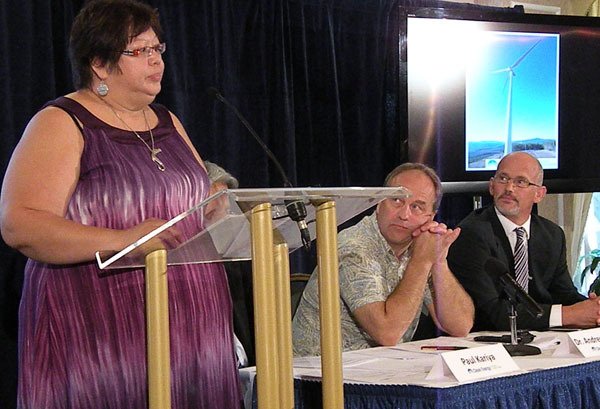VICTORIA – B.C.’s private power producers held a news conference here in the capital last week, to plead with the B.C. government not to back down from its target of self-sufficiency in clean energy by 2016.
The review panel looking at BC Hydro rates recommended that one way the utility might save money would be to change the definition of self-sufficiency. Currently that means having enough domestic clean electricity supply even in low water years.
The B.C. Clean Energy Association was supported by University of Victoria climate scientist Andrew Weaver, who wants B.C. to continue to develop its unique clean energy resources. That will reduce BC Hydro’s reliance on the open electricity market, and help to reduce demand for further coal and natural gas generation.
Weaver says people still skeptical about climate change should check out the current state of Arctic sea ice. It has retreated drastically again this summer and may reach an even smaller size than it did in 2007, which was the biggest melt since satellite records became available in 1979. The five greatest ice retreats have been in the past five years. The U.S. National Snow and Ice Data Centre reported Sept. 6 that both the Northwest Passage through Canada’s Arctic and the sea route north of Russia “appear to be open.”
Another supporter is Judith Sayers, a former chief from Nuu-Chah-Nulth territory on Vancouver Island, who now teaches aboriginal law at the University of Victoria. She talked about how a small hydro power project near Port Alberni allowed her people to learn business, with a light footprint on land recovering from a century of industrial logging. And she said that more than half of the First Nations in B.C. now have some interest in a power project.
Association president Paul Kariya explained how critics, notably the NDP’s John Horgan, manipulate rate figures to create an impression that independent power is hugely overpriced.
One out of three proposals never makes it to production. B.C.’s second wind farm, the Dokie project near Chetwynd, went broke, then was taken over and completed by Plutonic Power Corp and General Electric.
Here’s an indication of how quickly the clean energy field is evolving: This year Plutonic merged with Magma Energy Corp., which has geothermal assets in Iceland and Nevada. The merged company, Alterra Power Corp., has backed away from the vast Bute Inlet run-of-river proposal on the B.C. coast, but its nearby East Toba and Montrose river generators and the Dokie wind farm have performed better than expected.
The Bute project won’t go anywhere until the North American power market changes dramatically. Currently the market is low, due mainly to an abundance of cheap natural gas and government-subsidized wind power in the U.S.
Horgan claims private investment is a nefarious scheme to create a “parallel generating system” for private profit. That seems to be his key criterion for acceptable small hydro: as long as nobody makes a profit.
Professional environmentalists claim rivers have been destroyed. Their favourite villain, Ashlu Creek near Squamish, has been running smoothly for nearly two years, its critics silenced. A new run-of-river cluster around Harrison Lake has energized two remote native villages.
I’ve seen these things, from construction stage to mature operation. If that’s your idea of devastation, you should get out more, and acquaint yourself with the history of logging in particular.
And if you’re going to insinuate that this is political corruption, as Horgan does, you need a better case than the flimsy one he has presented so far.
Tom Fletcher is legislative reporter and columnist for Black Press and BCLocalnews.com
tfletcher@blackpress.ca twitter.com/tomfletcherbc
